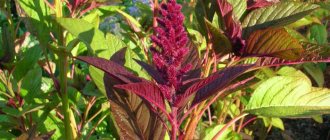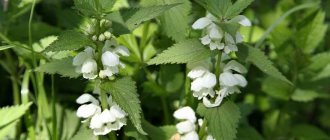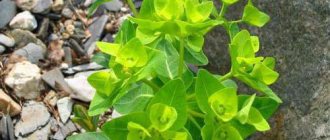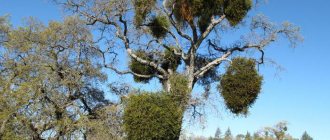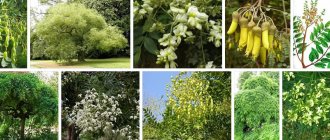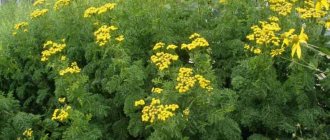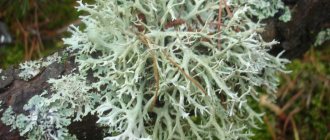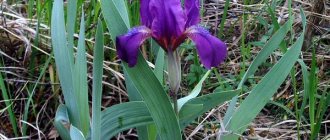Among the many representatives of the Rubiaceae genus, it is worth paying attention to woodruff Asperula, which means “fragrant” in Latin. The plant hides in shady areas and has a sweet smell, for which it is called jasmine. Small beautiful inflorescences are popularly called “St. George’s curls.” The healing power of the herb was known in the 16th century, where in the records of Benedictine monks there are references to Rhine wine infused with woodruff, which gives strength and strengthens the general condition of a person.
Botanical description
The annual or biennial groundcover has erect, tetrahedral stems. They are bare above, pubescent below, from 10 to 40 cm. Woodruff leaves are sessile, whorled, collected in rings of 8-12 pieces on the stem, and have thorns along the edges.
The rhizome is creeping, lies shallow in the soil, and grows well spontaneously.
The flowers are small, white, funnel-shaped, about 6 mm in diameter, collected in corymbose-shaped inflorescences.
photo of a plant in its natural habitat
Fragrant woodruff fully lives up to its name - both flowers and leaves smell. Aromatic phytocompounds are an important component that exhibit beneficial properties in medicine, cosmetology, and cooking.
There are about 200 species, among which is blue woodruff. A distinctive feature is long-lasting, until September, flowering and flowers of a blue, pale pink hue. This species is annual and prefers limestone soils. Perfect for decorative gardening, it looks original in alpine slides, ridges, and borders.
Distribution and habitats
It is found in the middle climatic zone of the Northern Hemisphere. Woodruff is known to residents of Europe, the Mediterranean, China, and Japan. In Russia it grows in the Caucasus, Western and Eastern Siberia, and the Far East.
Woodruff grass loves shady places and moisture, so it grows on loamy, sandy loam, slightly acidic soil in the basins of large rivers: the Dnieper, Don, Volga. In places of vegetation it selects the lower tiers of broad-leaved and mixed forests, coastal zones of small reservoirs, and ravines. Found in solitary groups in mountainous areas near water bodies.
woodruff is rich in biologically active substances beneficial for human health
Chemical composition
Fragrant herb is not included in the list of medicinal plants that are officially used in medicine. The oldest mentions of the healing power of asperula date back to 854 g, which reveal medicinal properties and contraindications. Research conducted by biologists confirms the rich composition:
- essential oils;
- coumarins, 0.83%;
- lactone asperuloside;
- resins;
- flavonoids;
- tannins, bitterness;
- acids: oxalic, kakhetinic, malic, tartaric.
There is fatty oil and ascorbic acid in small quantities.
Distribution and habitats
Woodruff fragrant grows in many countries of Eurasia, for example, in Austria, Bulgaria, England, as well as in the Mediterranean and CIS countries. In Russia, it grows mainly in the European part, as well as in Siberia and the Far East. The plant grows in the shade, on moist soil rich in humus, prefers deciduous, spruce and mixed forests. Grass can also often be found in meadows and mountain slopes.
There are about two hundred species of this plant; in the Russian Federation there are ninety species. In European countries, grass is planted specifically in order to subsequently prepare medicines from it.
Useful and medicinal properties of woodruff
Microelements filling the plant have a complex effect on the body:
- lactone is effective against inflammation, and together with coumarin has an antispasmodic effect;
- water infusion expands capillaries, improves blood flow without affecting blood viscosity;
- solves dermatological problems: dandruff, psoriasis, wounds, subcutaneous hemorrhages;
- essential oils help with expectoration and removal of mucus;
The coumarin contained in the plant has a beneficial effect; in small doses it calms smooth muscles and the nervous system.
The active substances contained in woodruff have a healing effect
pharmachologic effect
The active use of woodruff in traditional medicine is based on the presence of asperuloside and coumarins, thanks to which the prepared medicines have:
- diaphoretic;
- diuretics;
- choleretic;
- antiseptic;
- emollient;
- relieving pain syndromes;
- calming effect.
Tannins can stop bleeding and heal wounds. To do this, take fresh grass, apply it to the lesions, and bandage it. Change the bandage once a day until healing.
Description
Medicinal woodruff is a perennial herbaceous plant that belongs to the Rubiaceae family. It has a creeping and long rhizome, as well as straight, bare stems. The stems here are unbranched, they reach a height of about 10-40 cm. At the base of the leaves there are hairs in the form of rings.
The leaves of the plant are sessile. They have forward-facing spikes along the edges. The leaves in the lower part are lobed, they are collected in rings of 4-6 pieces. The upper leaves are lanceolate, they are collected in a ring of 8 pieces.
The flowers here are small, they are collected at the top of the stems with the help of three semi-umbrellas. Thus, they form a paniculate type constellation. The corolla here is white, four-parted. It blooms in June-July. The fruits ripen in August or September. As for the fruits, they are completely dry and covered with hook-shaped bristles. They can also split into two nuts.
Where does it grow
Woodruff grows in mixed and broad-leaved forests, as well as in the forest-steppe zone and on riverine sands. It has become widespread in Ukraine and Russia, in Crimea and Altai, in the Sayan Mountains, in the Far East and Central Asia. It can also be found in the basins of the Dnieper, Volga, and Don. Woodruff propagation is carried out by washing seeds, dividing rhizomes and cuttings.
Collection and procurement of raw materials
For medicinal purposes, woodruff grass is harvested during its flowering period. The collected herbs are dried in the air or in a room with good ventilation. For this purpose, raw materials are stored in jars in a dry room. Its shelf life is 1 year.
Compound
The composition of woodruff contains a large amount of coumarins, flavonoids, asperuloside lactone, essential and fatty oils, ascorbic acid, and tannins. Also present here are kakhetinic, malic, tartaric, oxalic, and silicic acids.
Properties, application, treatment
Woodruff has diuretic, pathogenic, sedative, and choleretic properties. It can also act as a laxative; many people use it due to its rapid effect on metabolism. Preparations based on this plant accelerate wound healing, relieve pain, slow down the heart rate and regulate heart function. That is why it is very popular in folk medicine.
An infusion prepared on the basis of woodruff herb should be taken orally for increased heart rate, neuralgia, jaundice, an attack of hysteria, as well as for cholelithiasis and kidney stones. This infusion will also be useful if you have inflamed intestines. It can be taken for diarrhea, dysmenorrhea, constipation. For coughs, woodruff is an excellent emollient.
Externally, the infusion of the herb is often used for washing, for compresses, and also in the treatment of ulcers, wounds, boils, abscesses, and rashes. Fragrant woodruff can be used as a single plant or as part of a composition with other remedies.
To cure rapid heartbeat and insomnia, woodruff is usually used together with simple motherwort or fragrant violet. It can also be used to treat inflammatory diseases of the gastrointestinal tract. These include colitis, enteritis, gastritis, enterocolitis.
If you are prone to skin diseases, then sweet woodruff can be used together with walnut leaves and linden flowers.
Sweet woodruff: medicinal properties
The first thing worth noting is the infusion of woodruff.
- In order to prepare it, you will need 2 tablespoons of chopped herbs, which must be poured with two glasses of boiling water. It needs to be left for an hour and then strained. You need to take the infusion half a glass 4 times a day. It can also be used for rubbing, as well as for compresses.
Woodruff infusion will help cure palpitations, insomnia and hysteria.
- To prepare it, you need to take 1 part of dry woodruff herb, 1 part of violet herb, 1 part of dry motherwort herb. All this needs to be poured with boiling water and left for 40 minutes, then strained thoroughly. You need to take a third of a glass of this mixture 4 times a day.
A medical infusion for the treatment of gastrointestinal diseases can be prepared as follows:
- take 2 parts of dry woodruff grass, 2 parts of medicinal lemon balm leaves, 1 part of oregano, 3 parts of strawberry fruits. Pour boiling water over 1 tablespoon and leave for 20 minutes, then strain. You can take all this 4 times a day.
To treat skin diseases, you should prepare a special infusion according to the following recipe.
- To do this, take 3 parts of fragrant woodruff, 3 parts of crushed dry string, 4 parts of dried linden flowers, 1 part of walnut leaves. Next, all this needs to be poured with boiling water and left for 20 minutes, and also strained. You need to take this infusion 1-2 glasses a day.
Contraindications
It is worth noting that the woodruff plant contains a large amount of coumarin. But it should never be used in large quantities, as it can cause poisoning, vomiting, nausea, stomach pain, headache and death. In case of poisoning, it is necessary to lavage the stomach with a solution of potassium permanganate, and then give the patient activated charcoal and a laxative with a high salt content. In the future, treatment will be based on symptoms. Please note that woodruff is a poisonous plant, which is why it is important to adhere to the dosage when consuming it.
Now you know everything about what woodruff is. This plant can have a great effect on your body if used in the right proportions and exactly as prescribed. In addition, this plant is convenient because it can be taken in any dosage form.
Harm and contraindications
Despite the described beneficial properties, you need to remember that the plant is poisonous. Incorrect dosage can cause unpleasant symptoms.
Contraindications are:
- pregnancy and lactation;
- children under 6 years old;
- individual intolerance to components;
- leukocytosis;
- diseases of the bladder and kidneys that are in the acute phase.
In case of overdose or intolerance, nausea, vomiting, dizziness, and pain in the chest appear. Stop taking the drug immediately and wash out the stomach. It would not be a bad idea to use Enterosgel or another sorbent.
traditional medicine uses the plant to prepare medicinal remedies at home
Contraindications
Woodruff has a toxic effect. Therefore, it must be taken with caution.
It is recommended to use plant-based preparations in small dosages. In case of overdose, the risk of poisoning increases, which is accompanied by nausea with vomiting and headache. When taking a large dose, even death is possible.
Woodruff should not be consumed by women who are carrying and nursing a child, as well as by children under six years of age. When undergoing a course of therapy, it is not recommended to consume salty foods, as well as fish and meat.
Application in medicine
Official medicine has not included jasmine extract in any medicine, but this does not prevent the use of aspirula, in other words, woodruff, to cure with the help of folk recipes:
- pain syndromes;
- neurological diseases;
- heart muscle dysfunction;
- metabolic disease;
- epilepsy;
- dysmenorrhea;
- mastopathy;
- respiratory diseases: cough, bronchitis;
- kidney and urinary tract diseases.
Also, perfumed greens are used as a prophylactic against the formation of stones in the bladder. The herb normalizes kidney function and eliminates nephroptosis. Biologically active substances strengthen the ligaments, forcing the kidneys to rise into place.
For external use, it is better to use a fresh plant in the form of a paste. If dried herbs are used to treat dermatological problems, you need to increase the concentration of the decoction.
Aspirula is a toxic, moderately poisonous plant, so the dosage is strictly monitored, especially when the drug is given to children.
Traditional medicine recipes using woodruff
Asperula woodruff is used both as an independent remedy and in combination with other medicinal plants, which mutually enhance the effect of bioactive substances. Good “partners” for heart ailments are collections of aromatic herbs: lemon balm, tricolor violet. When treating the stomach and intestines, woodruff is combined with oregano, wild strawberries, and motherwort. Skin diseases are treated with a mixture of woodruff, walnut leaves, and tripartite.
You can get useful substances from the plant in different ways: make tea, decoction, water infusion, alcohol tincture.
An important feature of treatment with fragrant woodruff is that during the period of taking the drugs, meat, fish products, salt, and all salty foods are excluded from the diet.
Woodruff infusion for insomnia and liver diseases
300 ml of boiled water pour 1 tbsp. dry raw materials. Leave for 20 minutes, filter. Drink 2 tbsp. during meals 3 times a day.
For nervous attacks
10 g of herb is infused in a glass of water, taken 4 times a day, a teaspoon.
when infused, all beneficial substances pass into the drink and provide medicinal properties
Decoction for schizophrenia
Brew 2 tbsp in 250 ml of boiling water. vegetable raw materials for 2-3 minutes. Leave for 15-20 minutes. They drink either in the morning, or at moments of manifestation of hysteria. Coriander can replace woodruff.
Chronic diseases of the digestive system
In the same way, a mixture of woodruff, oregano, strawberries, and lemon balm is brewed. After 20 minutes of infusion, take 3 times a day, after meals, 2 tbsp.
Correction of hormonal status, in particular, low FSH
The mixture will help produce gonadotropin secretion:
- 1 des.l. woodruff;
- 1 tsp sleep-herbs;
- 2 dess.l. Chernobyl.
The mixture is poured with 0.5 liters of boiling water and infused. Without straining, take 1/3 of the drink and drink throughout the day.
Skin diseases, wounds, ulcers
They use a combination of string, linden flowers, and woodruff in equal parts. Pour a teaspoon of herbs into a glass of boiling water. Take 0.5 cups orally before meals and externally in the form of a gauze compress.
For arrhythmia, tachycardia
A teaspoon of fragrant bedstraw is poured into 0.5 liters of good quality vodka. Leave for 2 weeks in a dark place. Drink 1 tsp before meals 3 times a day.
For epilepsy
It is recommended to prepare a mixture of hop cones, elecampane, mint leaves, and lemon balm. For 2 glasses of hot water you need to take 2 heaped tablespoons of the preparation. Leave until cool. Drink 100 ml at a time during the day. Treatment lasts 7-10 days, then a break is taken.
For dropsy
The disease, which is a consequence of diseases of the liver, kidneys, and heart, is treated with infusion. Take 30g of dry grass, pour 400 ml of boiling water. Leave for 2-3 days. Strain and add 50 ml of vodka. This medicine is taken 5 times a day, half a teaspoon. Noticed: if after 2 days the urine acquires a herbal smell, it means that the treatment is going well. If the smell appears later, it will take a long time to be treated.
For dysmenorrhea
Infuse a tablespoon of woodruff in a glass of cold water for 24 hours and drink throughout the day. Take 4-5 days at the beginning of the menstrual cycle.
Woodruff and men's problems
In “Herbal for Men” by Efremov A.P., Shreter A.I. Among the 300 medicinal plants, orchis occupies not the last place. Here are some recipes for treating the male genitourinary system.
Hyposexuality, weakened libido
The root of St. George's curls is a source of salep, and therefore is considered a powerful aphrodisiac. 30 g of orchis tubers, 20 g each of toadflax and cetraria herbs are poured into a glass of water and brought to a boil. Cool, strain, (drink once a day).
If you add 20 g of lemon balm, this remedy treats male infertility.
preparations with woodruff have a wide range of therapeutic effects and a wide range of applications
BPH
50 g of bedstraw and burnet grass are poured with 500 mg of water and boiled for 10 minutes. After cooling, strain, drink 4-5 times a day, half a glass before meals 15 minutes before or after meals an hour later.
Impotence due to physical fatigue or nervous disorders
2 tablespoons each of fragrant orchis root, lemon balm herb, walnut, wild mallow. The mixture is crushed, poured 1.5 liters of boiling water, left for 2 hours. Drink during the day. You can use sage instead of mallow leaves.
Chronic prostatitis
Mix 18 components, take 3 tablespoons of raw materials, pour 600 ml of boiling water.
| woodruff | Marshmallow (lek) roots | Elecampane tall | Valerian (lek) root | Hops, cones | creeping thyme |
| 40 g | 50 g | 100 g | 50 g | 40 g | 40 g |
| Common pumpkin, seeds | Hemp seed, seeds | Cherries, sweet cherries, stalks | Mistletoe, leaves | Rhubarb roots | Field steelweed, leaves |
| 25 g | 30 g | 30 g | 30 g | 30 g | 25 g |
| Goldenrod | Hazel, leaves | Bearberry, leaves | Flax, seeds | Common toadflax, leaves | Wheatgrass, roots |
| 40 g | 25 g | 75 g | 40 g | 25 g | 40 g |
Drink a glass 3 times a day.
Popular woodruff species
Woodruff , which is grown not only for decorative purposes, but also for use as a spice, has become widespread in culture The plant reaches a height of 10-50 cm, the flowers are small, pale pink, blue or white. Flowering occurs in May-July. Has a pleasant strong aroma.
Blue is an annual species, reaching a height of up to 50 cm. The flowers are blue, collected in umbellate inflorescences. Flowering lasts until September. The branched stems are covered with narrow leaves in sparse whorls. Prefers calcareous soils.
Gussona is a perennial species 5-10 cm high. The stems are collected in bunches and become woody at the base. The flowers are dark pink and only about 7 mm in diameter.
Brilliant (nitida) is a perennial plant native to Northern Greece. It is a low-growing bush with creeping shoots. A developed plant forms mats up to 5 cm high. The inflorescences are lush. Light pink flowers bloom in early summer.
Use in cooking
Tannins and essential oils can add a touch of tartness and interesting aroma to a Lenten dish. Leaves and stems are used in cooking in the same way as bay leaves: added at the end of cooking for a short time. Cooks use raw materials for cooking:
- lemonades, compotes;
- cognacs;
- cheeses;
- fruit and vegetable dishes;
- baked meat;
- smoked products.
In many foreign countries, woodruff seeds are sold on the shelves of vegetable departments. They are used to flavor alcoholic beverages, tea, and tobacco. The French make vinegar from the ground part, which brings out the taste of green salads made from lettuce and dandelion.
the plant has decorative qualities and is grown in the garden
Growing
Those who use the plant for medicinal purposes and want to always have raw materials on hand, plant orchis in the garden, in a shady flower bed, or in the nearest planting. Blue asperula is more suitable for gardening; it has a longer flowering period. The growing conditions for fragrant bedstraw should closely resemble its natural habitat.
Woodruff can be propagated by seeds, but this method requires a lot of time and some knowledge regarding agricultural technology. The seeds need to be collected, scattered on well-loosened soil, covered with fallen leaves, and watered. In the spring they will sprout, but the stems will be weak and will not bloom in the first summer. In the fall, the procedure of covering with leaves is repeated, and next summer the medicinal plant will be suitable for use.
In agricultural markets, seeds are bought under the outdated name Asperula fragrant or Woodruff fragrant. Spring sowing requires stratification. After purchasing the seeds, you need to take a bowl, place the seeds, sprinkling them with layers of peat, sand, and moss. This mixture should be moderately moist and kept in the refrigerator at 1 - 5⁰ for a month, with free access of air.
A common method of propagation is vegetative. In early spring or late September, the rhizome is dug up and transferred to a new habitat.
Care consists of watering on sunny, hot days, and removing weeds. Weeding should be superficial so as not to damage closely located roots. Fertilize with organic matter once a year.
To obtain medicinal raw materials, woodruff is collected during the flowering period
Description
Sweet woodruff belongs to the Rubiaceae family. It has a tetrahedral bare stem with a climbing rhizome at the base. The leaves are elongated, arranged in a ring around the stem in several tiers, and have thorny hooks along the edges. It usually grows in a small colony, which, due to the climbing structure of the roots, forms a carpet covering the soil. The flowers smell very spicy and strong. Distributed mainly in the Mediterranean regions and Eurasia.
How and when it is necessary to collect and prepare plant materials
To collect medicinal herbs, choose dry weather, because after rain and on a damp day the content of toxic substances in the stems and leaves is maximum.
Collection time is the period of budding and flowering of woodruff. Using a knife, sickle, or pruning shears, cut the stems at a distance of 10-15 cm from the ground. The workpiece must be dried as soon as possible so as not to lose valuable substances. The temperature in the drying cabinet is maintained at 40-45 degrees. Properly dried grass takes on a dark color. It is placed in a dry glass container and covered with a lid. Shelf life – 1 year.
In addition to treatment, fragrant bundles are placed in closets so that moths do not appear and things smell good.
Collection, preparation and storage
The plant blooms throughout the summer, starting in May, so it can be harvested during this period. This must be done in dry weather; in wet weather the plant is especially toxic. Woodruff grass and sometimes rhizomes are used as raw materials.
The tops of the stems are carefully cut off and dried quickly in the shade. The room should be well ventilated. You can also carry out thermal drying at a temperature of no more than fifty degrees Celsius. Dry grass, if properly prepared, should be dark in color.
Finished raw materials must be stored in glass containers that close tightly. The room where it will be stored should not be damp. The storage period should not exceed one year. If the plant has been stored for a long time, it is not recommended to use it.
X
